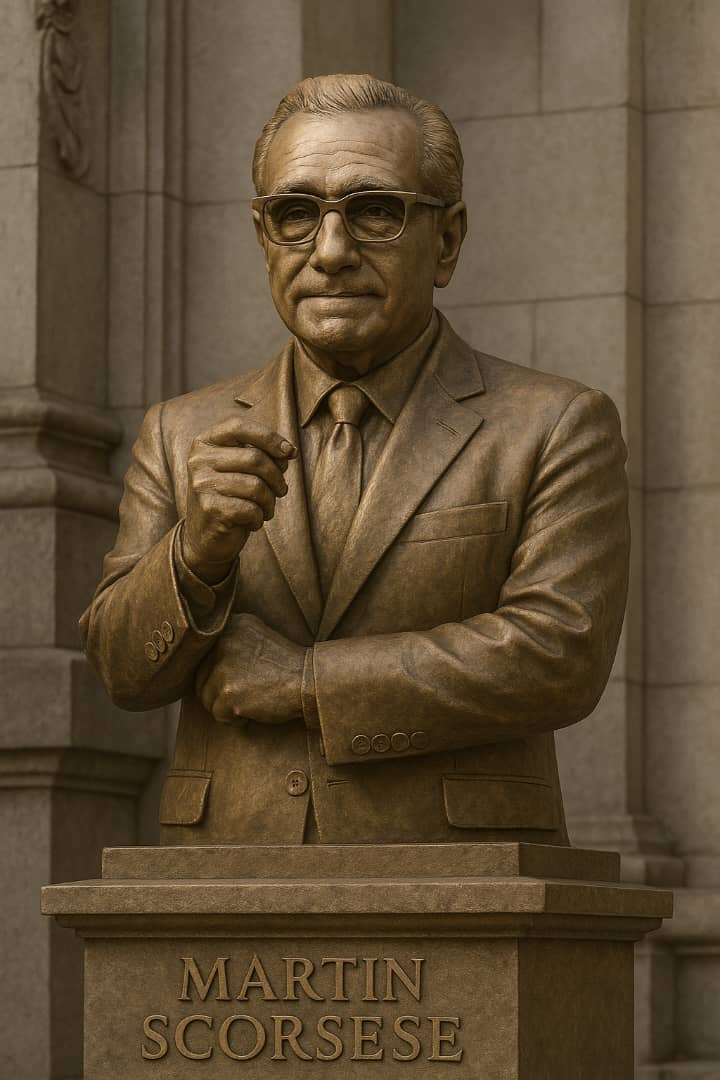Finally, the statue of Martin Scorsese has been officially mounted in New York, a city as iconic as the man himself. After years of proposals, discussions, and debates, the tribute to one of the most influential filmmakers in cinema history now stands tall, cast in bronze and immortalized for generations to come.
It is a momentous occasion not only for the film industry but also for the cultural fabric of New York City, which has been intricately interwoven with Scorsese’s cinematic vision.Located in the heart of Little Italy, a neighborhood that echoes with the memories of Scorsese’s childhood and the vibrant culture he often depicted, the statue serves as a profound symbol of artistic legacy. Tourists, locals, and fans from around the world are already gathering to witness this moment in film history. Standing with his signature glasses, slightly hunched yet full of energy, the statue captures Scorsese mid-thought—perhaps directing an imaginary scene or recalling a timeless line of dialogue.This tribute reflects more than just a career filled with accolades; it’s a monument to storytelling, perseverance, and authenticity.
Scorsese’s films often delve into the gritty, layered realities of life in New York, chronicling its contradictions with both affection and realism. From Mean Streets to Taxi Driver, Goodfellas to The Irishman, his work has shaped the global perception of the city and its many moods.The unveiling ceremony drew crowds from all walks of life—film students, veteran actors, civic leaders, and lifelong fans. New York Mayor’s speech highlighted Scorsese’s impact not just as an artist, but as a storyteller who understood the pulse of the city.
He described the statue as a long-overdue honor for someone who gave voice to the voiceless and light to the dark corners of urban life.The statue was crafted by renowned sculptor Elisa Martinez, known for her lifelike depictions of cultural figures. She spent months studying Scorsese’s movements, expressions, and public appearances to render a version that feels both respectful and alive. The final piece exudes an uncanny presence, a stillness charged with creative energy—as if Scorsese himself were about to utter something brilliant.It’s worth noting that the statue was funded by a combination of public arts grants and private donations, many from the film industry. Prominent directors, actors, and producers contributed to the effort, emphasizing the deep respect Scorsese commands among his peers. Names like Robert De Niro, Leonardo DiCaprio, and Steven Spielberg were all part of the initiative, publicly praising the man who shaped their careers and elevated cinema itself.While Scorsese has received numerous awards over the years, including an Oscar and the prestigious AFI Life Achievement Award, this statue marks a different kind of recognition—one that transcends plaques and trophies. It is an emblem of belonging, a testament to how deeply he is rooted in the city’s artistic and cultural legacy.The statue is more than a tribute—it’s a site of pilgrimage for aspiring filmmakers. Just like aspiring writers visit Hemingway’s haunts or musicians revere the Abbey Road crosswalk, budding directors will now have a tangible point of connection with their hero.
It is already being dubbed “the altar of cinema” by local students.In a moving statement, Scorsese himself addressed the crowd via a recorded message. With his characteristic humility, he expressed gratitude and disbelief. “I always thought of myself as a kid from Elizabeth Street,” he said. “To see a statue of myself here… it’s beyond words.” The message was met with thunderous applause, laughter, and a few tears.What makes this moment even more poignant is how it connects past and future. Scorsese’s films have always walked that tightrope—bridging generational gaps through universal themes of identity, morality, and human frailty.
This statue now serves as a similar bridge, linking an illustrious history to the promise of tomorrow.Nearby, a small installation of plaques tells the story of Scorsese’s life and work, featuring quotes from his films and collaborators. There are touchpoints for the public to hear audio snippets from his most famous movies and interviews. It creates an interactive space, turning the statue into a small open-air museum.The surrounding community has responded with immense pride. Local shops have already themed their window displays around Scorsese’s films, and a few cafes are serving dishes named after characters from Goodfellas and Raging Bull. It feels like a festival, a shared cultural awakening sparked by a figure who made their world known to millions.This moment also opens the door to conversations about how cities honor their cultural icons. In a time when public monuments are under scrutiny, the Martin Scorsese statue stands as a reminder that tributes can be meaningful, inclusive, and rooted in genuine impact. It honors not just the man but the values of creativity, persistence, and vision.For fans, this statue is more than a photo op—it’s a love letter to cinema. It speaks of a lifetime dedicated to the craft, of narratives that exposed truth, evoked emotion, and invited reflection.
It affirms that film can be art, and art can be immortal.As the sun sets over Little Italy and the statue gleams in the twilight, one can’t help but think that this monument was always meant to be here. Martin Scorsese has long been a towering figure in the world of film. Now, quite literally, he stands tall in the city that shaped him, and that he, in turn, helped define.



